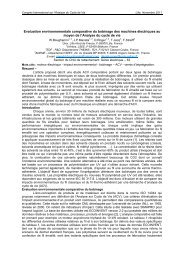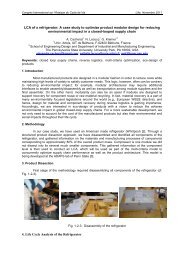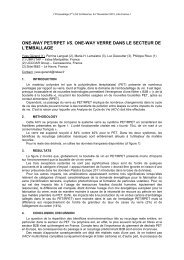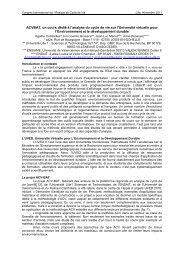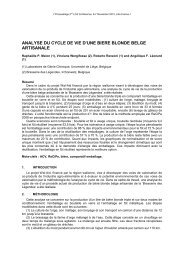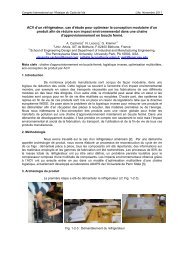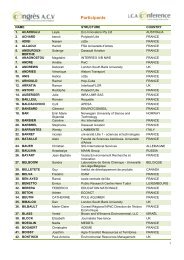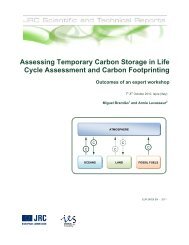Untitled - avniR
Untitled - avniR
Untitled - avniR
Create successful ePaper yourself
Turn your PDF publications into a flip-book with our unique Google optimized e-Paper software.
Congrès International sur l’Analyse du Cycle de Vie Lille, Novembre 2011<br />
Environmental impact of photovoltaic power by Life Cycle Assessment<br />
Saïcha Gerbinet, Sandra Belboom, Angélique Léonard<br />
Laboratoire de Génie Chimique – Procédés et Développement durable, Université de Liège, Belgium<br />
saicha.gerbinet@.ac.be; sbelboom@ulg.ac.be; a.leonard@ulg.ac.be<br />
Life Cycle Assessment (LCA) methodology has been used to determine the environmental impact<br />
of electricity produced from photovoltaics. LCA deals with the environmental aspects and potential impacts<br />
associated with all the stages of a product's life from raw material extraction through materials processing,<br />
manufacture, distribution, use, repair and maintenance, and ending by disposal or recycling. In this type of<br />
environmental assessment the energy and material flows for the entire life-cycle are surveyed and<br />
analysed with special attention to possible environmental hazard or human health problems. LCA also can<br />
be used to compare the environmental impact of different products or processes. A LCA consists of four<br />
interdependent steps defined by the norms ISO 14040 and 14044 [3; 4]: goal and scope definition,<br />
inventory analysis, impact assessment and interpretation.<br />
The environmental impact of the yearly electrical power usage of an average Belgian household,<br />
i.e. 3650 kWh, from photovoltaics has been calculated, and compared with the environmental impact of the<br />
electricity from the grid. For this analysis, a multicrystalline silicon solar cell module was chosen. Currently,<br />
the market share of the silicon modules is almost 90%. Multicrystalline silicon solar cells have a poorer<br />
yield but a lower production cost [10]. The selected module has an efficiency of 14 % and a performance<br />
ratio of 75 % which shows the proportion of the energy that is actually available for export to the grid or<br />
house use after deduction of energy loss (e.g. due to thermal losses and conduction losses). In Belgium,<br />
this module produces 102.6 kWh per year and per square metre. The entirety of its life cycle has been<br />
examined, except for its end of life because of the lack of knowledge in this field [1; 6; 8].<br />
120,<br />
100,<br />
80,<br />
60,<br />
40,<br />
20,<br />
0,<br />
Installation électrique<br />
Onduleur 3kWp<br />
Encadrement<br />
Production des modules<br />
Production des cellules<br />
Production des tranches<br />
Production de sog-Si<br />
Production de MG-silicone<br />
Extraction de la silice<br />
Figure 1: Characterization in relative percentages.<br />
The LCA of the panel has been performed in EndPoint using the ReCiPe method [2]. The<br />
characterisation shows the most penalising step is the production of silicon with high purity (figure 1). The<br />
Balance-Of-System (BOS) components, i.e. inverter and electrical conductor, have also a significant<br />
impact. The impact category concerning fossil depletion is predominant. Afterwards there are, in<br />
decreasing order, the impacts of climate change on human health, human toxicity and particulate matter<br />
formation.<br />
The sensitivity checks show the importance of the BOS components that are nevertheless often<br />
neglected in many studies. This is, above all, true in the categories concerning mineral depletion and, to a<br />
lesser extent, human toxicity, freshwater eutrophication and marine and terrestrial ecotoxicity.<br />
The sensitivity checks also show the impact of the technology used for silicon purification. Indeed,<br />
two technologies are available: the first uses scrap materials from the electronic industry because the<br />
degree of purity needed for silicon solar cells is somewhat lower than for integrated circuits. The second<br />
produces silicon exclusively for solar cell production, the so-called Solar Grade silicon (sog-Si). In the base<br />
case, the sog-Si has been considered [5; 7; 9]. In the sensitivity check, the use of scrap materials from the<br />
electronic industry has been studied. Using electronic grade silicon, the global environmental impact is four<br />
- 81 -



